Top News
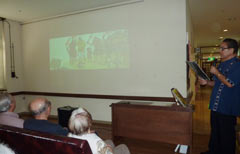
May 27, 2011 Ryukyu Shimpo
As part of their therapy, a picture-card show in Uchinaguchi or Okinawan dialect was held at the dementia day-care center “Deigoen” for aged patients of the Amekudai Hospital in Naha, on May 26. Okinawan dialect newscaster of the Radio Okinawa Masakazu Itokazu read the fairy tale picture book entitled “The Frog’s tug of war,” which was written by a well-known printmaker and writer Hiroshi Gima from Okinawa. Laughter and happy comments rose from among the forty people participated in the show as they listened to the familiar sound of uchinaguchi.
The center has held the show in the hope that the dementia patients might remember their own old stories when they hear uchinaguchi and the fairy tale.
A 70 year-old man was moved to tears when he heard Itokazu’s beautifully pronounced Naha dialect and expressed his gratitude in uchinaguchi.
Therapist and member of the staff of the facility Satoru Agarie said, “I’m glad that the patients listened so attentively to Itokazu. In recent years there are fewer and fewer opportunities to use uchinaguchi. I hope that some of the people remembered their old days.”
(English Translation by T&CT, Mark Ealey)
Go To Japanese
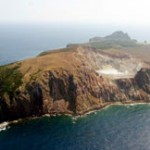
May 26, 2011 Ryukyu Shimpo
The Ministry of Defense (MOD) announced that it is considering relocating the Tori Shima range used by the U.S. military (0.04 square kilometers, Kumejima Town) to Iwo-Tori-shima (2.5 square kilometers, Kumejima Town), located in the northernmost region of Okinawa.
Defense Minister Toshimi Kitazawa explained this at the Okinawa Policy Council meeting held on May 23.
Because of the considerable travel distance involved for the U.S. military, the MOD is also considering using the Iejima Auxiliary Airfield as a fuel supply point.

Iwo-Tori-shima
In an interview with the Ryukyu Shimpo, Mayor of Kumejima Town Choukou Taira, stated his opposition to the proposal, saying, “I have not heard anything from the Japanese government about this and I have no intention of providing town-owned land for it. If it is true that the MOD is considering such a relocation, it makes me very uncomfortable indeed.”
It is reported that on May 25 Mayor Taira telephoned Rou Manabe, the head of Okinawa Defense Bureau, to state his opposition to this proposal.
The U.S. military have mistakenly fired depleted uranium bullets at the Tori Shima range in the past. The harmful effects on the surrounding environment and the risk of the land being submerged due to the change in its shape because of military training have been a cause for concern for some time.
Although Okinawa Prefecture and Kumejima Town have both requested the early return of Tori Shima range, there is no indication that this is going to happen.
The MOD is considering changing the location for the training currently carried out at the Tori Shima range in order to secure the return of the island.
A top MOD official said, “We are not trying to move the location for the training to somewhere else within the prefecture, nor out of the country, but to the most appropriate spot.” The MOD is considering relocating the Tori Shima range, located about 28 kilometers north of Kumejima, to Iwo-Tori-shima, a deserted island located about 190 kilometers north-northeast of Naha.
The Council for the Promotion of Dezoning and Reutilization of Military Land in Okinawa requested the return of the Tori Shima range at a meeting held on May 23 to discuss how to alleviate the burden of hosting U.S. military bases.
Japanese government said, “We would like to discuss with the U.S. government what might be possible to implement from the point of view of reduction of the impact on the local community.”
About Iwo-Tori-shima
A deserted island in the northernmost region of Okinawa, located 190 kilometers north-northeast of Naha and 65 kilometers west of Tokunoshima, Kagoshima Prefecture.
The island has seven kilometers of coastline and comes under the jurisdiction of Kumejima Town. Comprising two conjoined volcanoes, Iwo-Tori-shima is the only active volcano island in Okinawa. It has been the source of sulfur since the time of the Ryukyu dynasty, when its sulfur was taken as a tribute to China. Its northwest volcano erupted in 1956. One month of falling ash and ash deposits caused the island’s entire population to leave.
The latest eruption was confirmed as occurring in July 1968.
(English Translation by T&CT, Mark Ealey)
Go To Japanese

May 31, 2011 Hiroko Sato of Ryukyu Shimpo
Typhoon No. 2 lashed the Okinawa area during the two days of May 28 and 29, causing extensive damage. A total of 68 injuries had been reported by May 30, including two people in a critical condition. According to prefectural government statistics, at least in the last ten years, there has never been a case in which the injury toll exceeded 60 people for a typhoon in May. This is the first time among such May typhoons that a maximum wind speed of more than 100 knots has been recorded since the Okinawa Meteorological Observatory commenced recording statistics in 1951. “This is an exceptional typhoon for May,” said an official at the observatory. The Disaster Risk Management Division of the prefectural government issued an alert, warning: “Do not go outside during the typhoon, and take storm protection measures to cover window glass.”
The Annual Report of the Prefectural Emergency Management shows that in the past ten years there have been two cases of typhoons causing more than 60 casualties – in September in 2003 and the same month in 2006. Typhoon No. 14 of September 2003 inflicted the most serious damage with 94 people with minor and serious injuries with one person killed. Typhoon No. 13 of September 2006 caused injuries ranging from minor to critical to 66 people, and in 2010, a total of 18 people were injured by the four typhoons that occurred that year.
The Risk Management Division of the prefectural government explains, “We think that many people were injured by broken glass or were knocked over by the typhoon’s strong winds.” They speculate that, “The particularly strong winds have made the damage worse,” and once they analyze the damage over the whole area they will consider what measures might be taken in future.
According to Observatory staff, the previous strongest winds had been recorded at 84.9 knots in Miyakojima in 1951, and 59.5 knots on Okinawa’s main island in 2001. An average of 0.4 typhoons hit Okinawa each May, but it is the first time that two typhoons, No. 1 followed by No. 2, came in such quick succession. Two typhoons hit in May 1966, but not so close to each other.
With regard to typhoons in May, the senior forecaster at the Observatory, Masaru Shimajiri, explained that, “A tropical cyclone was likely to occur because of meandering westerlies with vigorous convective activity over the sea east of the Philippines. In this region typhoons usually change their course and slow down, but No 2. was very unusual. It increased its speed to approximately 80 to 100 knots around Okinawa,” he said. The senior forecaster suggested that, “The meandering westerlies may have increased the speed of the wind.”
(English Translation by T&CT, Mark Ealey)
Slideshow of Typhoon No.2’s picture(interval 5sec)
Go To Japanese
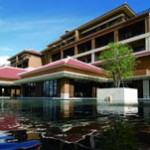
May 25, 2011 Ryukyu Shimpo
On May 24 it was reported that the forei Learn more here gn-based luxury resort hotel group Ritz-Carlton will operate the Kise Bettei Hotel & Spa located in Nago City, that is currently run by Kanehide Resorts Co., Ltd. The two companies will enter into a contract in mid-June. Kise Bettei will be closed temporarily from September so the renewal of the facilities can be carried out, but is expected to reopen early next year as a Ritz-Carlton hotel. People in the tourist industry hope that the Ritz’s deployment in Okinawa will expand the section of the market aimed at more wealthy tourists.
The Kise Bettei has a seven-story hotel building with hotels and spas within its grounds that cover approximately 33,400 square meters. With 97 rooms and 11 cottages, and complete with restaurants and treatment rooms, it is a luxury resort for adults.
To date, the hotel’s clientele have been affluent baby boomers and people from outside the prefecture, but its occupancy rate has dropped due to the overall decrease in the number of inbound tourists, the domestic economic downturn and the rise in the value of the yen after the bankruptcy of Lehman Brothers in 2008. Kanehide Resorts had been considering developments and looking for ways to cooperate with other hotel management companies. The renovations that will begin in September include additional safety measures to cater for children among the guests.
The Ritz-Carlton is a worldwide luxury hotel chain, based in Maryland in the United States. It operates 79 hotels and resorts in major cities around the world, with hotels in Japan opening in Osaka in 1997 and in Tokyo in 2007.
(English Translation by T&CT, Mark Ealey)
Go To Japanese
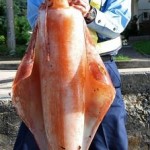
May 22, 2011 by Hideaki Yoneda correspondent of Ryukyu Shimpo
At around 7:30am on May 18, when out on patrol Sergeant Sadao Yoshihara of the Tokashiki Village Police Station found a large squid, known as “sodeika” or diamond squid, floating alive in water about 50 centimeters deep near the edge of the surf at Tokashiki Fishing Port. He and a friend caught it by hand. The squid was about one meter in length and weighed 13 kilograms.
Sodeika are known as “seika” in the Okinawan dialect, and are caught in the deep sea. According to fishermen, now is the season when these squid come close to shore to spawn.
Every morning, as part of his routine, in front of the Tokashiki Elementary and Junior High School gate Yoshihara keeps an eye on the school children and instructs them on road safety.
On 18 May, he found this large squid while he was out on patrol before the children came out to go to school. The first big-catch for him as a Tokashiki police sergeant, with a smile on his face, he said, “This proves that good things happen if you get up early.The early police sergeant catches the big squid.”
Many school children and teachers came up to touch the squid. The sergeant reported that fillets of the catch were distributed to everyone to eat raw as sashimi or cooked.
(English Translation by T&CT, Mark Ealey)
Full Image(223 x 480 Pixel)
Go To Japanese
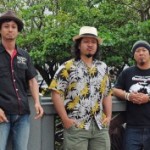
May 24, 2011 by Takahiro Miyagi of Ryukyu Shimpo
On May 18, Okinawan band Mongol800 released a new album entitled “Etcetera Works II” featuring a number of their songs released since 2009. The band arranged well-known songs from all over the globe such as “What a Wonderful World” and “Honen Ondo” into their own style.
Mongol800 will use this new album to launch a national tour, starting with performances in Human Stage in Ginowan City on May 28 followed by one at Sakurazaka Central in Naha City on May 29.
The three members of the band, which successfully held concerts in China, plan to further develop their presence in the Asian market. They said, “We hope that Mongol800 can serve as a bridge between Okinawa and other Asian countries.”
The new album includes many tribute songs such as “Oriko San (Pet) by THE BOOM” and cover songs. Two new songs are included, one of which, “Boku and Jelly,” evokes a feeling of floating.
Kiyosaku Uezu (bass guitar/vocals) said, “This new album almost turned out to be like an original album. We tried some things that we had never done before, but there is no change in our style. We’ll be glad if people see this album as being unique to Mongol800.”
Besides performances in live music houses in Beijing and Shanghai from June 1 to 6, Mongol800 took part in one of the largest rock festivals in China.
Satoshi Takazato (drums) said, “We sang in Japanese, which is of course a foreign language to the audience, but they seemed to enjoy it. It was really quite strange.”
Uezu said, “We would like to perform in other Asian countries while we are away on our national tour and would like to serve as a bridge between Okinawa and other Asian countries through music. We would be glad if musicians from China would come to music festivals in Japan and broaden the scope of cultural exchange.”
On their national tour, Mongol800 will perform in some of the areas stricken by the Great East Japan Earthquake.
Takashi Gima (guitar) said, “We can offer support to the victims of the earthquake from here in Okinawa, but it would be the best for us to perform live for them. We want to deliver live performances to audiences across the whole country.”
The price of the new album is 2500 yen.
The band will donate part of the sales to a fund to support people in the areas affected by the earthquake.
(English Translation by T&CT, Mark Ealey)
Go To Japanese

May 25, 2011 by Takashi Hokama of Ryukyu Shimpo
“Let’s travel to Okinawa.” The media in Asian countries and regions such as South Korea, China, Taiwan, and Hong Kong, appear to be actively promoting travel to Okinawa.
In the context of a decrease in tourists to Japan after Great East Japan Earthquake, representatives of 41 media related companies from Asia visited Okinawa during the period from April 11 to May 23.
Most of the companies, which mainly covered radiation contamination concerns related to Japan’s nuclear power plants, were very clear in their reporting that Okinawa is totally safe.
The China Times, one of the four major newspapers in Taiwan, introduced the Naha-shi Kosetsu Ichiba (Naha City Public Market), which had not been reported to any great extent overseas before, emphasizing the safety of food in Okinawa by covering the abundant variety of food available there.
Okinawa is the first Japanese prefecture to welcome tourists from Hong Kong, which suspended tours to Japan soon after Great East Japan Earthquake.
The Okinawa Prefectural Government said, “We would like to erase from Okinawa the image of Japan as being dangerous. We think that media coverage could have flow-on benefits in the future.”
The Okinawa Convention & Visitors Bureau (OCVB), which strives to attract tourists, said, “We would like to give the tourism industry a lift. It has been in a slump, so we hope to attract tourists from overseas in summer.”
Because of the Great East Japan Earthquake, the number of the tourists from overseas decreased by 44.4% (6700) to 8400 compared with the same month the previous year.
Working together with overseas travel companies and planning tours accompanied by media people, the prefectural government and the OCVB have tried hard to reactivate the tourism industry. The travel companies intend to work on new, innovative plans for Okinawan tourism in years to come.
While the number of the inbound tourists from Asian countries into Okinawa did not increase in April, a representative of OCVB said, “We intend to persist in using the media to convey the safety and appeal of Okinawa.”
(English Translation by T&CT, Mark Ealey)
Go To Japanese
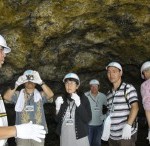
May 21, 2011, Ryukyu Shimpo
Designed to foster a greater understanding of Hansen’s disease and to help eliminate prejudice and discrimination against those afflicted by it, “The 7th General and Exchange Gathering of Public Conference on Hansen’s Disease in Nago, Miyako Island,” was held at the National Sanatorium Miyako Nanseien, in Miyakojima City in the afternoon of May 20. This was the first time that this meeting has been held in Okinawa.
At the exchange gathering, held under the banner “Thinking about war and Hansen’s Disease,” former patient of Miyako Nanseien, 76-year old Sakae Uezato, talked about his experiences during the Battle of Okinawa.
Miyako Nanseien was closed around March 1945 when resident staff abandoned the facility. Forced out by the Japanese military, the patients took refuge in caves along the coastline. “Many died of malaria, dysentery and malnutrition,” said Uezato. He continued, “When I came back to the sanatorium in September, not knowing that the war was over, I found that the 15 or 16 patients who had been in the boys’ hut with me had disappeared, so I was the only one who survived.”
Uezato wants people to understand the truth about those suffering from Hansen’s disease, saying, “Those with the disease have been plagued by discrimination and prejudice caused by the Japanese government’s misguided policies. People who have recovered have been living secretive lives on the fringe of society.”
The meeting included some fieldwork in which participants visited the facilities in the sanatorium and went to the caves along the beach.
Thirty-eight year-old Fumiaki Kaku, who now works for a self-support facility for disabled people, said, “It was a valuable experience. I wanted to know how disabled people were treated during the war. I now understand how they were shunted off to quite awful situations.”
Another meeting is scheduled to be held in Nago Civic Center on May 21 followed by a local meeting in Okinawa Airakuen, a national sanatorium, on May 22.
(English Translation by T&CT, Mark Ealey)
Go To Japanese
May 25, 2011 Ryukyu Shimpo
On May 25, Chairwoman Mitsuko Tomon, mayor of Okinawa City, and other leaders of the Trilateral Liaison Council concerning U.S. Kadena Airbase met with Colonel David Nahom, commander of the 18th Operations Group, 18th Wing, Kadena Air Base to protest against parachute training in the base that had been held without prior notice. The group of local leaders indicated that in addition to the parachute training being carried out in a location other than the Ie Jima Auxiliary Airfield stipulated in the SACO agreement (Special Actions Committee on Okinawa between the United States Government and the Government of Japan), it was also done without prior notice. “This represents a lack of consideration for residents on the part of the military officials. It is absolutely unacceptable,” they said. In response, the U.S. military claimed that the training was carried out in an appropriate manner, indicating that there is a considerable gulf in approach between the military officials and the local leaders.
According to the chairwoman of the Trilateral Liaison Council, Tomon, and the other local leaders, the base commander insisted that it was out of the ordinary and held on small scale, but within the parameters approved by the U.S. and Japan. He said that it was carried out safely and that there was no need to give prior notice. “The U.S. military explained that the training was safe, but local residents are uneasy about this kind of thing. There is a considerable difference in thinking between the military and residents,” said Tomon.
The local leaders of the Trilateral Liaison Council concerning U.S. Kadena Air Base met with Takashi Daito, the deputy director of Okinawa Defense Bureau, to request that a stop be put to the training. “Personally, I think that this training can be described as ‘out of the ordinary.’ We can’t tell them to stop necessary training.” But at the same time, he said, “It is a fact that local residents are uncomfortable about this,” and explained that the Defense Bureau had not received any prior notice either. The deputy director stated that the Bureau had commented to the U.S. military that this was “extremely regrettable.”
(English Translation by T&CT, Mark Ealey)
Go To Japanese

May 22, 2011 photo by Hiroaki Yamashiro, photographer of Ryukyu Shimpo
The Noguchigera or Okinawa woodpecker, designated as a special national treasure and found in the forests of the Yambaru in the northern part of Okinawa, has entered the fledging brood season.
Around midday on May 20, I was lucky enough to observe the rare sight of two chicks suddenly appearing at the same time in a woodpecker nest dug in a dead tree on a mountain in the Kunigami area. Judging from the times that the parent birds were carrying food, their beak color, shape and other differences of the chicks, I think that there were three chicks in the nest. One of them hooked its feet on the nest entrance as it surveyed the scene, probably not too long away from departing the nest.
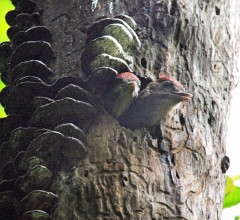
Wanting food, two chicks make their appearance out of their nest at the same time. Taken in the afternoon of May 20, in the Kunigami Mountains area.
Kuniaki Higa, of the Bird Study Group of Okinawa said, “I have never seen two chicks make an appearance at same time. I think that they are probably in good health and are ready to compete with each other for food from the parent bird. I hope that they make their first flight from the nest safely.”
(English Translation by T&CT, Mark Ealey)
Go To Japanese
Go To Video
Slideshow of The Noguchigera’s picture(interval 5sec)

May 24, 2011 by Seikaku Umeda of Ryukyu Shimpo
On May 23, Yuko Kinjo, president of the Grace Rum Co., based at Minami Daito Village, shipped about 1000 bottles of rum to France for use in hotels and restaurants.
The company produces its rum from local sugar cane and sells it as a local product of the island. This is the first time for the company to make a proper shipment overseas beyond small quantities previously shipped for exhibitions.
Two varieties were shipped, one using the juice of sugar cane grown in Minami Daito Island called “CORCOR AGRICOLE” and the other called “CORCOR” made mainly using molasses produced when making sugar.
Grace Rum was founded in 2004. The Minami Daito factory is capable of producing 8000 bottles of rum a month.
This shipment had been dispatched from the island for France before the Great East Japan Earthquake occurred, but most export cargo from Japan was held up because trucks were not operating because of gasoline shortages and rolling power-cuts in Tokyo, and they were also required by their business partner in France to submit a document to certify the safety of rum after the nuclear power plant disaster. The shipment of rum finally got through to the customer on May 12.
Kinjo said, “We can’t expect to increase the numbers of rum drinkers in this country, so we are going to try to sell in foreign countries where the people have a love affair with rum. I am planning sales of “CORCOR” to liquor shops in the United Kingdom and then across Europe.”
(English Translation by T&CT, Mark Ealey)
Go To Japanese












 Webcam(Kokusai Street)
Webcam(Kokusai Street)


